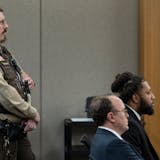The century-old letter could have been penned today. LaVerne Roquette was writing her boyfriend, Russell Rathbun, about a new and "awful" virus.
"All the towns and cities for miles around are all closed — everything but the meat markets, grocery, and dry good stores," wrote 23-year-old LaVerne on Oct. 10, 1918, at the peak of the deadly influenza pandemic that had just gripped her. "At some places people have to wear gauze masks when they appear on the streets … the government has closed all schools, churches, theatres."
Holly Hannah Lewis found her grandmother LaVerne's letter amid 84 courtship correspondences with her grandfather Russell in a shoe box tucked in a brass trunk her mother once used as a coffee table. She had never seen the letters until her mother, Rosemary Hannah, died in 2018 at 97.
Shuttered in her Minneapolis home during the bitter winter of 2019 and sequestered during the coronavirus shutdown, Lewis, 73, shaped the letters into a 125-page book for family members.
"It has been captivating to journey back into the last century," Lewis said, noting that her grandmother's descriptions of the 1918 flu pandemic are "so parallel to our own experience."
LaVerne and Russell met at the Roof Garden of the Hotel Radisson in Minneapolis, where young people gathered to dance in the spring of 1917 just as the United States entered the First World War.
Russell, born in Missouri in 1889, moved north to attend the University of Minnesota. Only 5 feet 3 with blue eyes and dark hair, he earned the nickname "Bunny" as a Gophers track and cross-country star and was known as a megaphone-toting football cheerleader.
When the U.S. joined World War I, Russell was 27 and working as a banker in Detroit Lakes, Minn. He quickly made his way to the Twin Cities to sign up for the war. Maybe his gung-ho attitude was genetic — his family's roots wound back to the American Revolution.

